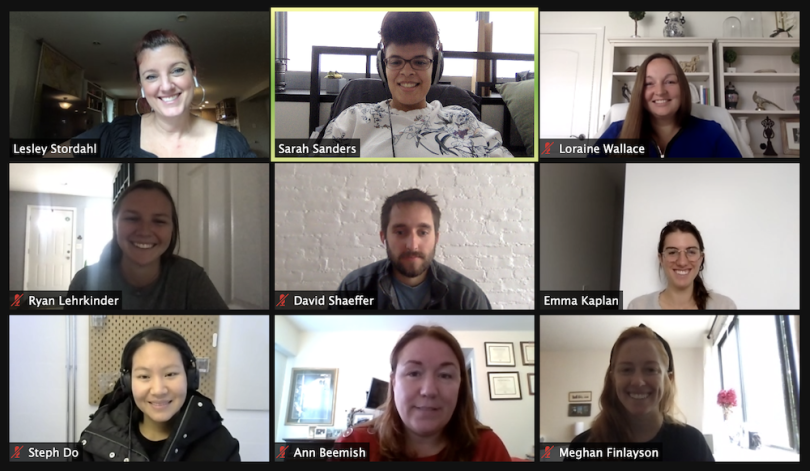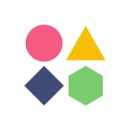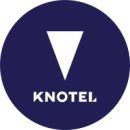In 2015, TJ Fitzpatrick shared a YouTube video of his failed attempts trying to get an automatic soap dispenser to work.
When the dispenser wouldn’t work, Fitzpatrick, a black man, invited his friend, who was white, to give it a try. Upon doing so, he got the dispenser to work on the first go.
The video went viral and a conversation sparked around what happens when companies fail to invite diverse voices to product cycle stages; for example, when key user groups are ignored and employees don’t feel well-represented at their workplace and in its corresponding solutions.
As many companies in the tech industry continue to launch D&I initiatives that aim to give people from underrepresented groups a louder voice, Built In SF caught up with several to learn how their organizational-wide efforts impact their employees, product and brand.

Before launching a product update that gave college students the opportunity to share their gender identity and pronouns on Handshake’s employment platform, teams conducted week-long interviews with students to understand how they wanted to be represented. Product Design Manager Molly Garber shared the impact of this initiative, along with how else Handshake prioritizes inclusivity in their product and at their company.
What steps have you taken to make diversity and inclusivity a priority across your entire business? What was key to aligning everyone behind this effort?
Our mission is to democratize access to opportunity and ensure any student can build a great career no matter who they know, where they live or what school they attend. Our leadership has woven this sentiment into every aspect of our business, from onboarding new team members, to our pitch decks for clients. Internally, we’ve adopted the phrase, “Students first.” We use this to prioritize decisions and discussions at every stage of our product process and culture.
To further support and foster inclusion within our organization, we set up employee resource groups from our early days as a company. Our employee-led groups bring folks together around shared experience, identities and interests. These groups not only foster social connection but also help support and make recommendations for ways we can improve our large company culture and product goals to continue to foster belonging. Recently, we launched a larger D&I committee of leaders from our employee resource groups, managers from across our organization and passionate employees. This group will continue to help us grow and improve our culture.
How do you ensure your products, branding and messaging cater to a diverse audience?
Since our students are highly diverse, we make sure to create a highly inclusive platform. A recent student product initiative focused on helping students express their gender identity and pronouns authentically on our platform. We aim to connect employers with more underrepresented candidates while allowing students to express themselves authentically and safely on Handshake.
Our product, design, content and engineering teams spent a week doing interviews with multiple students to ensure we had a good sense of how they wanted to be represented on Handshake. After these sessions and competitor audits, we decided to design a field with type-ahead functionality to suggest options, but not enforce them. We believe this will allow students to authentically represent themselves on our platform while also being inclusive to everyone. We also allow our students to provide multiple pronouns and customizable visibility preferences.
We have constant design reviews with our teams to make sure that we are building accessible and inclusive product features.”
What impact have external D&I efforts had on your internal culture, employer brand and/or hiring? How do you measure or gauge that success?
Diversity, equity and inclusion are a very high priority, not only at Handshake, but also on our design team. We design experiences for a very diverse generation of students, and our team must be representative of our students. On our team, we have designers that grew up in communities across the country and received a variety of different types of education.
Our diversity grows even more with our product and engineering teams. Since our design team is on the smaller side, we lean on our product and engineering team to bring diverse thinking to our design process. We have constant design reviews with our teams to make sure that we are building accessible and inclusive product features. This includes everything from building for screen readers to making sure we support students who only have mobile access. Our diverse teams attract new talent that is underrepresented to join our organization and help us to build better products.

Will May, VP of Americas Enterprise Sales at Zscaler, said he focuses on creating unity on his team to promote inclusion. Recently, he put this into practice after taking on a new business segment and inviting leaders from varying backgrounds at the internet security company to establish a theme for the product.
What steps have you taken to make diversity and inclusivity a priority across your entire business? What was the key to aligning everyone behind this effort?
One of the greatest opportunities of leadership is to promote unity through building. When working for a technology company that values growth and disruption, you are constantly creating new segments, products and teams. From the onset, you must prioritize building a team of diverse talent and stress the importance of real-time collaboration. If you do this right, then you will create something special where everyone feels like they were a key contributor in the build process and will remain loyal to the team as it scales.
How do you ensure your products, branding and messaging cater to a diverse audience?
At the start of this fiscal year, I took over a new segment of our business. After assessing the situation and building some early convictions of change areas, I met with a cross-functional set of leaders and asked for their input on the business. Collectively, we built a theme to rally behind called “Shoreline.” We chose a story to drive home this image about Florence Chadwick, the first woman to swim across the English Channel in both directions. I had a woman message me after our meeting saying how much she was inspired by the story, and that in her entire career of sales, she’s never heard a keynote story at a sales kickoff that focused on a woman.
One of the greatest opportunities of leadership is to promote unity through building.”
What impact have external D&I efforts had on your internal culture, employer brand and/or hiring? How do you measure or gauge that success?
Zscaler prioritizes D&I strongly internally and externally. We have a documented framework of what we want our culture to look like. Having our staff prioritize this and intentionally define the culture makes it easier to explain to external candidates what it’s like to work at Zscaler and how to get involved beyond the core job. This makes it easier to recruit in a competitive market for top talent.
Additionally, there’s a growing list of employee resource groups that all spin out of our “Z-Cares Team,” which oversees our giving back, D&I, and environmental sustainability groups. We continue to evolve how we track leadership development, internal and external hiring processes and employee engagement.

Diversity, inclusion and collaboration are seen as everyone’s responsibility at Cisco Meraki, according to Jessica Gilbert, who heads up inclusion and collaboration at the company, which provides cloud-controlled Wi-Fi, routing and security products. Gilbert shed some light on how that translates into practice and product.
What steps have you taken to make diversity and inclusivity a priority across your entire business? What was the key to aligning everyone behind this effort?
It’s not just up to my team or our senior leaders; we’re all accountable. We identify this as a priority through clear articulation of our values, business priorities and leadership expectations. We recently conducted a listening tour with our employee resource organizations to understand their experiences at Cisco Meraki and get their input into strategy development. We’ve established a three-year inclusion and collaboration strategy based on that input, which will guide our efforts globally.
How do you ensure your products, branding and messaging cater to a diverse audience?
In February, when we began a refresh of our external website, I reached out to our marketing team to discuss how we could model inclusion. During the planning process, I spent time with the team discussing how to ensure that all our customers and partners saw themselves reflected on our site. Representation matters. As the team continues to build out marketing materials, we’ve expanded that effort to make sure the images in our collateral are representative and unbiased. We’re now working with our employee resource organizations to build an inclusive marketing advisory board that will help us do this on a regular basis.
It’s not just up to my team or our senior leaders; we’re all accountable.”
What impact have external D&I efforts had on your internal culture, employer brand and/or hiring? How do you measure or gauge that success?
Our internal culture and values drive our external efforts. Our external work is shaped by who we are, and that’s critical. If our external footprint is inconsistent with what we’re saying or doing internally then it’s just lip service and employees will recognize the disconnect. “Care deeply” is one of our core values and that care extends to the communities we work with. Giving back is something that we encourage our employees to do. Seventy-seven percent of Merakians participate in giving programs, whether through time or donations. Merakians can take up to 40 hours of paid time off to volunteer with organizations and causes they believe in. We foster this as an organization through our Meraki Gives global employee network.
We’re also focused on establishing partnerships with community organizations to build an inclusive future for all. Our partnership with National Able Network in Chicago is a great example of this. National Able helps 76,000 individuals who are diverse and face multiple barriers and hundreds of employers in the Midwest every year. During our 2-year partnership with National Able Network, we’ve conducted teaching labs for their students and have hired a number of network support engineers and associates from their programs.

At Helix, a personal genomics startup, diversity in data plays a huge role in driving its product. “One thing that every person on this planet has in common is their DNA,” said Director of Product Management Kirsten Mouritsen. “It’s also at the core of what makes us diverse and different.”
What steps have you taken to make diversity and inclusivity a priority across your entire business? What was the key to aligning everyone behind this effort?
Helix’s goal is to empower every person to improve their life through DNA. We apply this externally with our efforts to partner with population health research projects to reach as many people as possible for genetic testing and also in our work with them to ensure that we’re recruiting the most diverse test population. From a purely statistical and scientific perspective, the more diverse a data set is, the more accurate your findings will be, so it’s been very natural to take the inclusive perspective of our population genetics studies and have it translate to aligning around inclusion as a company goal.
How do you ensure your products, branding and messaging cater to a diverse audience?
From a product perspective, we integrate steps in our UX design process to ensure that we take users from all backgrounds and experiences into mind. On a larger scale, we do user testing on the UX itself and for comprehension of the results or information about users’ genetics that they’ll be receiving from the product. We try and ensure that we have testers from diverse backgrounds and levels of experience with genetics to ensure that we’re able to make the benefits of the knowledge gained in our products as accessible to as many people as possible. On a smaller scale, we evaluate the specific language that we use, especially when collecting demographic data, to ensure that it's inclusive of all.
We integrate steps in our UX design process to ensure that we take users from all backgrounds and experiences into mind.”
What impact have external D&I efforts had on your internal culture, employer brand and/or hiring? How do you measure or gauge that success?
We have always had an open dialogue about diversity within the company, and the events of this summer put the ideals of the larger movement into focus for us and reminded us of the impact our company can have with our genetic and now COVID-19 testing. Our D&I committee has re-upped efforts to promote diversity from within our walls and has partnered with an outside consultant to help us create success metrics.
In the meantime, our recruiting team has updated practices so we can improve the diversity of our candidate pool as we ramp up hiring for our COVID-19 testing business.

“Fly your flag” has been a core pillar at Knotel since its 2016 inception. Kim Rodgers, who oversees global people operations at the flexible workspace platform, said this pillar encourages people to be themselves and not check their identity at the door. However, following the death of George Floyd, Rodgers said Knotel has responded with a series of new initiatives that support anti-racism within the company.
What steps have you taken to make diversity and inclusivity a priority across your entire business? What was the key to aligning everyone behind this effort?
More recently, the senseless death of George Floyd earlier this year was a tipping point for many Knotel employees who felt very strongly about using their voice and platforms to speak out against systemic racism and long-standing societal inequities. As a result, we formed an anti-racist initiative with quantifiable objectives to help Knotel become actively anti-racist in every aspect of our company. The subgroup has executive buy-in from leadership, meets regularly with well-defined goals and objectives and is staffed by a diverse and well-represented group of Knotel employees from all levels and departments of the company.
How do you ensure your products, branding and messaging cater to a diverse audience?
We’ve spent a lot of time over the last several months listening and learning from our employees, our partners and leaders in the industry. We’ve been intentional in soliciting feedback and perspectives from our employees as we work to ensure they feel heard and valued in the workplace.
We’ve been consistent with our internal and external communication as a way to keep our teams apprised but also to demonstrate the seriousness of our commitment to becoming actively anti-racist. That communication happens through a diverse set of channels, like email, our all-hands meetings, press interviews and Slack, to ensure stakeholders feel apprised of our intentions and our progress against those stated objectives.
We also empower our teams with the tools and content they need to post on their own, as a representation of their personal brand. A small example of that would be updating our corporate email signatures for the month of June with the colors of the Pride flag.
Knotel's ANTI-RACIST AGENDA:
- Emphasizing internally the importance of language and terminology to drive a shared understanding of the problem at hand
- A monthly internal D&I newsletter
- Pulse surveys to gauge employee responses
- Studying successful D&I initiatives at other companies and evaluating external advisors to partner with for corporate activism
- A 10-episode diversity webinar series featuring D&I executives from major corporations
What impact have external D&I efforts had on your internal culture, employer brand and/or hiring? How do you measure or gauge that success?
We launched a diversity series in June to elevate voices across corporate America who could help us better understand the nuances and complexity of dismantling deeply-embedded racial inequities, both in the workplace and more broadly across society.
That effort consisted of more than 10 webinars and virtual chats with leaders from across the corporate spectrum, including the chief diversity officers at Netflix, SAP, Asana, Meredith Corporation and more. The series produced a slew of learnings and insights on effective methods and tools for promoting and championing diversity and inclusion within the workplace. It was well-received by our employees as well as partners of the company and was just one part of a broader effort to advance this much-needed conversation.













